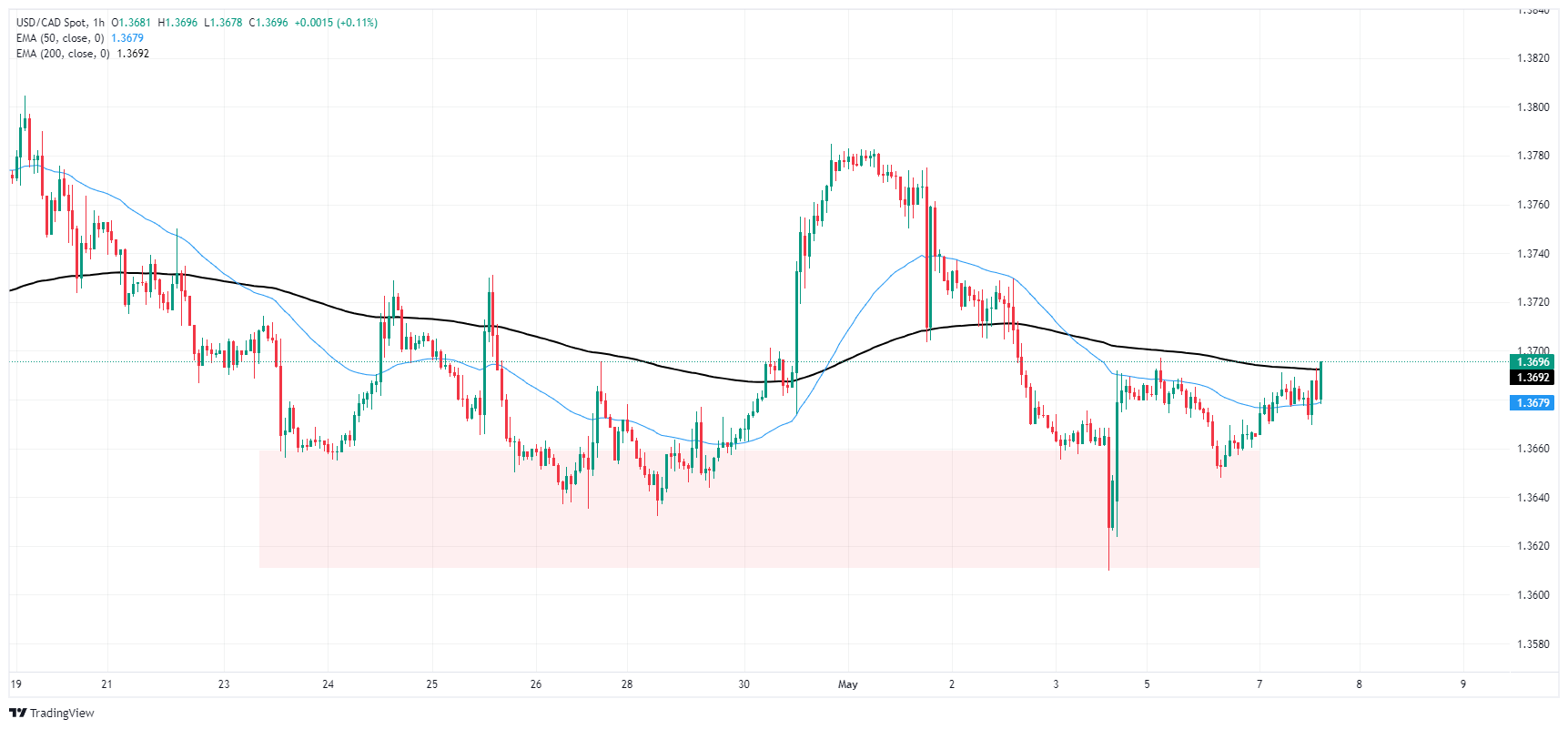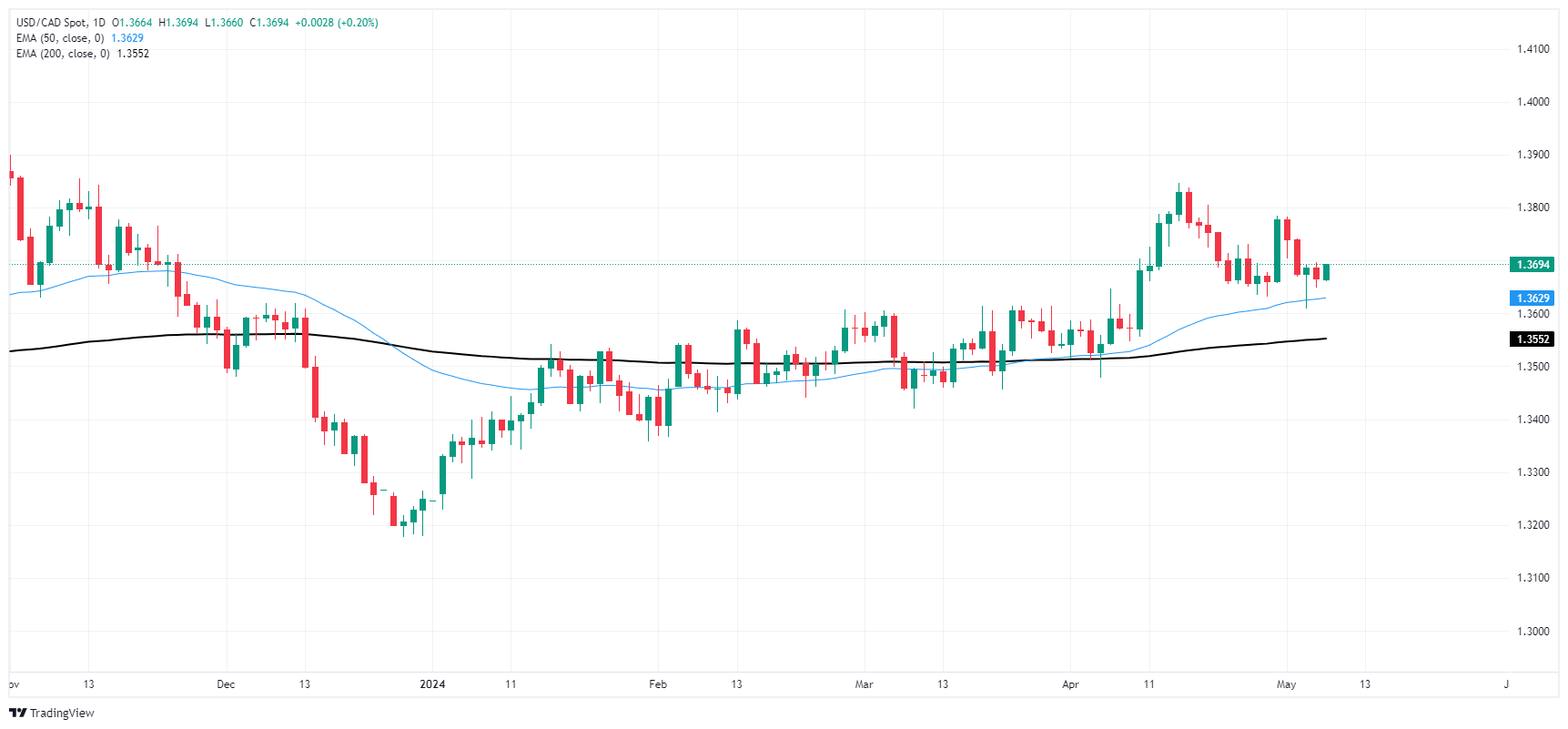- The Canadian dollar gives way, but remains at average levels.
- Canadian PMI beat expectations in April.
- CAD markets await Canadian jobs data on Friday.
The Canadian Dollar (CAD) fell broadly on Tuesday but remained near near-term technical levels as CAD markets shrugged off better-than-expected Canadian Purchasing Managers' Index (PMI) numbers. Markets are awaiting statements from Federal Reserve (Fed) officials as investors focus on the prospects for a Fed rate cut.
Canada reported an improvement in the seasonally adjusted PMI for April, a sign that business leaders in the public and private sectors of the Canadian economy see an improvement in overall business activity. However, battered crude oil markets and falling barrel prices limit the CAD's ability to find higher ground.
Daily Market Moves Summary: Canadian PMIs Fail to Spark Bullish Interest
- The seasonally adjusted Canadian PMI for April improved to 63.0 from 57.5, beating the forecast of 58.1.
- The Ivey PMI for April hit its highest level in two years, recording the highest activity survey result since May 2022.
- Broader markets remain focused on the Fed's words as investors wait for signs of rate cuts from the Fed.
- The Bank of Canada's (BoC) financial system review on Thursday is expected to produce market moves.
- CAD traders will be watching Friday's Canadian net employment change and unemployment rate numbers.
- The net change in Canadian employment is expected to add 20,000 net jobs in April, following a decline of -2,200 the previous month.
- The Canadian unemployment rate is expected to rise to 6.2% in April, slightly up from 6.1% the previous month.
Price of the Canadian Dollar today
Below is the percentage change of the Canadian Dollar (CAD) against the currencies listed today. The Canadian Dollar was the weakest currency against the Euro.
| USD | EUR | GBP | CAD | AUD | JPY | NZD | CHF | |
| USD | -0.07% | 0.13% | 0.20% | 0.17% | 0.15% | -0.09% | 0.00% | |
| EUR | 0.08% | 0.20% | 0.28% | 0.26% | 0.25% | -0.01% | 0.10% | |
| GBP | -0.12% | -0.20% | 0.09% | 0.08% | 0.06% | -0.20% | -0.09% | |
| CAD | -0.19% | -0.30% | -0.07% | -0.01% | -0.03% | -0.29% | -0.18% | |
| AUD | -0.17% | -0.26% | -0.06% | 0.01% | -0.01% | -0.28% | -0.16% | |
| JPY | -0.15% | -0.25% | -0.05% | 0.02% | 0.00% | -0.26% | -0.15% | |
| NZD | 0.11% | 0.01% | 0.23% | 0.29% | 0.29% | 0.26% | 0.12% | |
| CHF | -0.03% | -0.10% | 0.09% | 0.17% | 0.16% | 0.14% | -0.13% |
The heat map shows the percentage changes of the major currencies against each other. The base currency is chosen in the left column, while the quote currency is chosen in the top row. For example, if you choose the Euro in the left column and scroll down the horizontal line to the Japanese Yen, the percentage change that appears in the box will represent EUR (base)/JPY (quote).
Technical Analysis: Canadian Dollar Stubbornly Swims in Known Circles
The Canadian Dollar (CAD) is generally softer on Tuesday, giving up most of Monday's early gains to trade in familiar bids. The Canadian dollar remains flat to bearish, losing around a third of a percentage point against the New Zealand dollar (NZD) and the Euro (EUR). Against the US dollar (USD), the CAD fell by around a quarter of a percentage point.
On Tuesday, the USD/CAD pair approached the 1.3700 area, while the Canadian dollar shook off Monday's slim gains. The pair is moving into congestion near the 200 hourly EMA at 1.3697, and the Canadian Dollar has lost most of the gains found after last Friday's Non-Farm Payrolls (NFP) US will drag the pair to 1.3610.
Candlesticks show USD/CAD finding short-term technical support at the 50-day EMA at 1.3629, with long-term bullish pressure at the 200-day EMA at 1.3552. The pair continues to decline from the mid-April high near 1.3850, but USD/CAD is still trading higher on the year, up 3.4% from January's opening bids near 1.3250.
USD/CAD Hourly Chart
USD/CAD Daily Chart
Risk Sentiment FAQ
What do the terms “risk-on” and “risk-off” mean when referring to sentiment in financial markets?
In the world of financial jargon, the two terms “risk appetite (risk-on)” and “risk aversion (risk-off)” refer to the level of risk that investors are willing to bear during the investment period. reference. In a “risk-on” market, investors are optimistic about the future and are more willing to buy risky assets. In a “risk-off” market, investors begin to “play it safe” because they are worried. for the future and, therefore, buy less risky assets that are more certain to provide a return, even if it is relatively modest.
What are the key assets to follow to understand risk sentiment dynamics?
Typically, during periods of “risk appetite”, stock markets rise, and most commodities – except gold – also appreciate as they benefit from positive growth prospects. The currencies of countries that are large exporters of raw materials strengthen due to increased demand, and cryptocurrencies rise. In a “risk-off” market, Bonds rise – especially major government bonds -, Gold shines and safe-haven currencies such as the Japanese Yen, Swiss Franc and US Dollar benefit.
Which currencies strengthen when sentiment is “risk-on”?
The Australian Dollar (AUD), Canadian Dollar (CAD), New Zealand Dollar (NZD) and minor currencies such as the Ruble (RUB) and the South African Rand (ZAR) tend to rise in markets where there is “appetite for risk.” This is because the economies of these currencies rely heavily on commodity exports for their growth, and these tend to rise in price during periods of “risk appetite.” This is because investors anticipate higher demand for raw materials in the future due to increased economic activity.
Which currencies strengthen when sentiment is “risk averse”?
The major currencies that tend to rise during periods of “risk aversion” are the US Dollar (USD), the Japanese Yen (JPY) and the Swiss Franc (CHF). The Dollar, because it is the world's reserve currency and because in times of crisis investors buy US public debt, which is considered safe because it is unlikely that the world's largest economy will go into default. The Yen, due to the increase in demand for Japanese government bonds, since a large proportion is in the hands of domestic investors who are unlikely to get rid of them, even in a crisis. The Swiss franc, because strict Swiss banking legislation offers investors greater capital protection.
Source: Fx Street
I am Joshua Winder, a senior-level journalist and editor at World Stock Market. I specialize in covering news related to the stock market and economic trends. With more than 8 years of experience in this field, I have become an expert in financial reporting.







